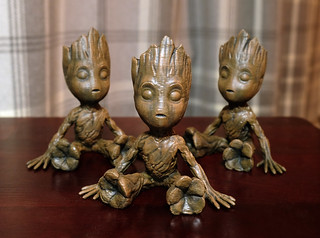So much to learn! Arrrrgggg! 😲
...In the background I am slowly learning to 3D model from a software perspective BUT I am also intrigued by the modelling aspects of 3D printing in a more tangible sense. What can I do with a PLA printed model? Can I sand it? Can I paint it? Etc, etc...
This just shows what a complete noob I am to the world of 3D printing. I don't even completely understand the properties of the print material, whether it be PLA, PLA+, PETG or ABS (to name but a few types of filament). I'm still trying to learn the pros and cons of each, but - in the meantime - I'm sticking to the basic - jack of all trades-ish - PLA!
Anyway, I needed a test project to try out modelling craft skills on a PLA model and I settled on this little chap...
Baby-Groot seemed a good test piece as he'll make a nice birthday present for my daughter (the model is actually a small plant pot for an 'air plant').
I was VERY pleased with this model - the first medium sized print I have done and only the third print in total - though the candy red filament that came with the printer to get you started is a little gaudy. I'd really like to get a nice neutral grey or even black PLA for future models.
Anyhoo... The quality of resolution of the print was a lot better than I expected. Yes, close-up you see that characteristic 'stepping' pattern that 3D prints inherently create when building up the layers of filament, but the models I have created so far have been a lot smoother than I expected AND these have been set to print on the 'standard' quality setting and not 'high'!
To further smooth out the prints I wondered how priming would affect the surface of the model (I also was keep to get a better look at the general detail as the candy red filament kinda hid some of the finer detail as it was so garish)...
Using a grey primer spray certainly showed just how well the Flashforge Adventurer 3 could render models and the layer of paint did help smooth out some of the print pattern (and it worked very well with the PLA). I did a bit of further research and I discovered that you can buy what's called a filler/primer spray, this is a slightly more gloopy primer paint that can fill in some small imperfections and gives a smoother surface (allegedly). That may be worth a try in the future - hopefully it won't fill in detail so much as to obscure it (we shall see)...
I then added my first paint 'base' layer, naturally I went for a medium 'wood' colour. For some reason this particular brand of paint came out a little glossy - which was annoying - but it does make the 3D model look rather nice.
However, I decided that this mid-colour was still a bit too light and so I ended up experimenting with some darker washes and dry brushing - just as I used to do with my plastic kit models - to darken and give the wood effect some depth...
Pretty good, eh? (If I say so myself.) One thing that concerned me about using a liquid shadow wash - was whether the thinned paint would highlight the 3D stepping pattern by seeping in between the print layers. But, the good news is that while it did the layers of filler and base paint smoothed out these layer lines just enough to not make this such a big deal - you just need to go easy with your wash and dry-brushing.
[Note: You will have noticed that my single Baby-Groot has suddenly become three Baby-Groots! 😁 This was because of a unintended effect of having a 3D printer - as I found that all of a sudden I had family members asking me if I could 'just print me a copy' of whatever it was I was printing! 😐]
I finished the model off by painting in in the eyes and that's fairly much it...
All in all, this has been a very interesting and informative first exercise. Working with a 3D printed model is very similar to how you might go about working with a plastic kit - though you have to be wary of the printing pattern and try to alleviate it - either by sanding and filling the model OR by printing it out at a higher resolution.
Next I will be looking more into creating a scale model print and how I go about creating a tiny recreation of a real world object.






No comments:
Post a Comment